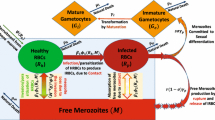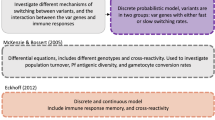Abstract
We consider an intra-host model of malaria that allows for antigenic variation within a single species. More specifically, the host’s immune response is compartmentalized into reactions to major and minor epitopes. We investigate the conditions that lead to transient oscillations, which correspond to recurrent clinical episodes of the diseases, and how a small delay in the activation of the immune response can lead to persistent oscillations. We find that the efficacies of the immune responses to the major and minor epitopes, defined in terms of rate constants, play a crucial role in determining when there will be transient oscillations. The delay necessary to excite persistent oscillations, the time duration between disease episodes and their severity are also expressed in terms of the immune response efficacies. In addition, we describe how the severity and duration of the oscillations depend upon the parasite propagation rates and the immune response efficacies.
Similar content being viewed by others
References
Agur, Z., Mehr, R., 1997. Modelling Trypanosoma congolense parasitaemia patterns during the chronic phase of infection in N’Dama cattle. Parasite Immunol. 19, 171–182.
Anderson, R.M., 1998. Complex dynamics behaviors in the interaction between parasite populations and the host’s immune system. Int. J. Parasitol. 28, 551–566.
Anderson, R.M., May, R.M., Gupta, S., 1989. Non-linear phenomena in host-parasite interactions. Parasitology 99, S59–S79.
Antia, R., Nowak, M.A., Anderson, R.M., 1996. Antigenic variation and the within-host dynamics of parasites. Proc. Natl. Acad. Sci. USA 93, 985–989.
Blyuss, K.B., Gupta, S., 2009. Stability and bifurcations in a model of antigenic variation in malaria. J. Math. Biol. 58, 923–937.
Carr, T.W., Billings, L., B Schwartz, I., Triandaf, I., 2000. Bi-instability and the global role of unstable resonant orbits in a driven laser. Physica D 147, 59–82.
Carr, T.W., Schwartz, I.B., Kim, M.Y., Roy, R., 2006. Delayed-mutual coupling dynamics of lasers: scaling laws and resonances. SIAM J. Dyn. Syst. 5, 699–725.
Dawes, J.H.P., Gog, J.R., 2002. The onset of oscillatory dynamics in models of multiple disease strains. J. Math. Biol. 45, 471–510.
De Leenheer, P., Pilyugin, S.S., 2008. Immune response to a malaria infection: properties of a mathematical model. J. Biol. Dyn. 2, 102–120.
Engelborghs, K., Luzyanina, T., Samaey, G., 2001. DDE-BIFTOOL v.2.00 user manual: a Matlab package for bifurcation analysis of delay differential equations. Technical Report TW-330, Dept. of Computer Science, K.U. Leuven.
Ferguson, N., Anderson, R., Gupta, S., 1999. The effect of antibody-dependent enhancement on the transmission dynamics and persistence of multiple-strain pathogens. Proc. Natl. Acad. Sci. USA 96, 790–794.
Gardner, M.J., Hall, N., Fung, E., White, O., Berriman, M., Hyman, R.W., et al., 2002. Genome sequence of the human malaria parasite Plasmodium falciparum. Nature 419, 498–511.
Gatton, M.L., Peters, J.M., Fowler, E.V., Cheng, Q., 2003. Switching rates of Plasmodium falciparum var genes: faster than we thought? Trends Parasitol. 19, 202–208.
Gravenor, M.B., Kwaitkowski, D., 1998. An analysis of the temperature effects of fever on the intra-host population dynamics of Plasmodium falciparum. Parasitology 117, 97–105.
Gurarie, D., Zimmerman, P.A., King, C.H., 2006. Dynamic regulation of single- and mixed-species malaria infection: insights to specific and non-specific mechanisms of control. J. Theor. Biol. 240, 185–199.
Iggidr, A., Kamgang, J.-C., Sallet, G., Tewa, J.-J., 2006. Global analysis of new malaria introhost models with a competitive exclusion principle. SIAM J. Appl. Math. 67, 260–278.
Kevorkian, J., Cole, J.D., 1996. Multiple Scale and Singular Perturbation Methods. Springer, New York.
Kosinski, R.J., 1980. Antigenic variation in trypanosomes: a computer analysis of variant order. Parasitology 80, 343–357.
Kwiatkowski, D., Nowak, M., 1991. Periodic and chaotic host-parasite interactions in human malaria. Proc. Natl. Acad. Sci. USA 88, 5111–5113.
MacDonald, N., 1989. Biological Delay Systems: Linear Stability Theory. Cambridge University Press, Cambridge.
McKenzie, F.E., Bossert, W.H., 1997. The dynamics of Plasmodium falciparum blood-stage infection. J. Theor. Biol. 188, 127–140.
McKenzie, F.E., Bossert, W.H., 1998. A target for intervention in Plasmodium falciparum infections. Am. J. Trop. Med. Hyg. 58, 763–767.
Molineaux, L., Dietz, K., 1999. Review of intra-host models of malaria. Parasitologia 41, 221–231.
Oaks, S.C., Mitchell, V.S., Pearson, G.W., Carpenter, C.J. (Eds.), 1991. Malaria—Obstacles and Opportunities. Institute of Medicine, National Academy Press.
Recker, M., Gupta, S., 2006. Conflicting immune responses can prolong the length of infection in Plasmodium falciparum malaria. Bull. Math. Biol. 68, 821–835.
Recker, M., Nee, S., Bull, P.C., Kinyanjul, S., Marsh, K., Newbold, C., Gupta, S., 2004. Transient cross-reactive immune responses can orchestrate antigenic variation in malaria. Nature 49, 555–558.
Shampine, L.F., Thompson, S., 2001. Solving DDEs in Matlab. J. Appl. Numer. Math. 37, 441–458.
Strogatz, S.H., Mirollo, R.E., 1993. Splay states in globally coupled Josephson arrays: analytical prediction of Floquet multipliers. Phys. Rev. E 47, 220–227.
Taylor, M.L., Carr, T.W., 2009. An SIR epidemic model with partial temporary immunity modeled with delay. J. Math. Biol. 59, 841–880.
Author information
Authors and Affiliations
Corresponding author
Rights and permissions
About this article
Cite this article
Mitchell, J.L., Carr, T.W. Oscillations in an Intra-host Model of Plasmodium Falciparum Malaria Due to Cross-reactive Immune Response. Bull. Math. Biol. 72, 590–610 (2010). https://doi.org/10.1007/s11538-009-9462-2
Received:
Accepted:
Published:
Issue Date:
DOI: https://doi.org/10.1007/s11538-009-9462-2




